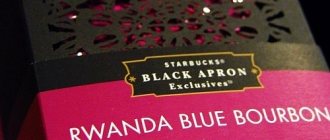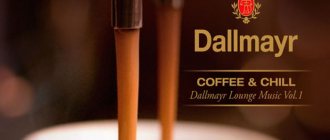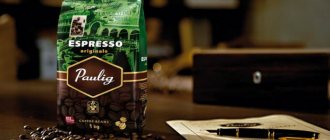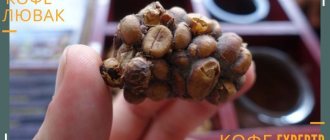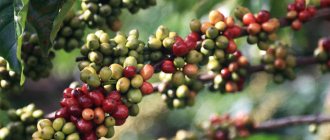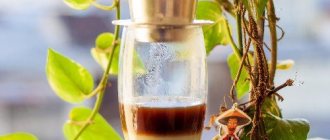The variety of Finnish coffee brands can pleasantly discourage any buyer of aromatic beans who decides to wander into the store. Residents of St. Petersburg are especially lucky, as they have the opportunity to regularly and directly import coffee from Northern Europe. Which brand is the best and what to look for when buying - this is the main topic for tourist thoughts.
Coffee from Paulig
The Paulig concern is the leader in coffee production in Finland. Most popular brands belong to him.
Finnish coffee Juhla Mokka
The most famous brands of Paulig coffee and their degree of roasting (strength):
- Juhla Mokka (1) and Juhla Mokka tumma paahto (2) are ideal for evening gatherings with friends;
- Presidentti (1) and Paulig Presidentti tumma paahto (3) for preparing a “celebratory” drink with a mild taste;
- Brazil (2) from the Brazilian variety of santos beans;
- Presidentti Black Label (4) with a chocolate aftertaste thanks to Kenyan Arabica;
- Presidentti Gold Label (4) premium blend of Arabica beans from Ethiopia and Papua New Guinea;
- Parisien Coffee (5) made from robusta beans, usually drunk with milk.
In addition to the listed brands, the Paulig line includes Arabica, Espresso, and Mokka coffee blends of varying degrees of roasting and taste.
Which Finnish stores sell coffee?
To buy coffee, you should turn to well-known supermarket chains.
- Lidl is one of the most widespread stores in Finland. There are more than 170 branches throughout the country. It has a favorable pricing policy: German Lidl is a budget option for purchasing. The supermarket is open until nine in the evening and has a wide selection of products, which adds to its popularity. The franchise's homemade coffee is sold freely.
- S Group is a retail chain located in the Baltic countries, Finland and Russia. “S” regularly offers discounts on food products.
- K-citymarket has a history of half a century. This is the largest franchise in Finland, often combining hypermarkets with coffee shops in its branches. “K” is in first place in providing Finns and tourists with the cheapest coffee in the country - with a promotion it is possible to buy “Paulig” for just two euros.
Meira
The second most popular coffee brand in Suomi is Meira. Finns love it for the good taste of the drink and low prices.
Finnish coffee Saludo
The most famous brands of Meira coffee and their degree of roasting:
- Saludo (1) from Arabica beans grown in Latin America;
- Kulta Katriina (1-3) with a slight sourness due to the presence of robusta.
How much does coffee cost
- “Paulig”, depending on the type, costs from 4 to 6 euros (~280–425 rubles). Mokka is the company's most affordable product, Presidentti is the most expensive. Its cost can rise to 11.5 euros per kilogram, which equals ~ 800 rubles. Brazil costs an average of 5 euros (355 rubles) per 500 grams.
- “Kulta Katriina” from Meira costs 2.8 euros ( ~ 200 rubles).
- Lidl’s home brand “Hieno Kahvi” sells for 2.9 euros (~205 rubles) per half a kilogram of compressed product.
You should start your trip to Finland by visiting coffee shops and coffee shops. In them, the aromatic drink will cost more, but this gives you the opportunity to try as many varieties and roasting options as possible, and choose the ones you like.
Coffee from Sweden
There is quite a lot of Swedish coffee in Finnish stores. The most popular products are from the Gevalia brand, which is a supplier to the Swedish royal court. Gevalia coffee is offered in roasts from 2 to 4, has a delicate aroma and taste without sourness.
Coffee Gevalia
The products of the Swedish brand Lofsberg Lila are also made from Arabica. The Kharisma brand allows you to get a drink with a nutty aftertaste, and Magnifika - with a chocolate aftertaste.
Good Life Coffee
In 2012, renowned Finnish barista Lauri Pipinen opened Good Life Coffee in Helsinki's Kallio district, wanting to change the way people thought about coffee. Two years later, he joined forces with coffee enthusiast Samuli Ronkanen and the powerhouse duo founded Good Life Coffee Roasters.
A lot has changed since then: the Helsinki cafe closed at the end of November 2021, but the roastery continues to operate at full capacity, supplying aromatic coffee to coffee shops in Finland and other countries, as well as selling coffee in an online store. Particular attention continues to be paid to high-quality ingredients and carefully selected roasting methods.
“Our core idea is that getting good coffee is not that difficult,” Ronkanen explained. “You buy the best ingredients and use clean equipment and good water.” Of course, in the roastery we use all sorts of technical tools and put a lot of effort into making sure the coffee tastes good. We take care of all those details and responsibilities to make it easier for customers.”
Where can I buy
There are departments with coffee from Finnish and Swedish brands in every supermarket. There are also specialized coffee shops. To be fair, prices are often lower in supermarkets. But in specialized stores they will tell you in detail about each type of coffee.
When choosing which package of coffee to buy, you need to pay attention not only to the popularity of the brand and the degree of roasting. If you buy coffee not in beans, grinding is important, which determines the recommended preparation method. It is usually indicated by a small design of a cup, a Turk, or a coffee machine on the package.
Features of the coffee ritual in Finland
Finnish coffee is not so much a tradition as it is an addiction and a habit. According to statistics, Finns drink more coffee than any other people in the world - about 12 large cups daily. True, their drink - kahvi - is no different in strength and is more reminiscent of an Americano. Finns do not use any additives, and if they do use them, it is extremely rare. Finnish style does not imply anything superfluous, and therefore in their coffee shops there is practically no division between latte, espresso and other types of drink.
Pikakahvi - instant coffee - is not particularly liked by Finns: they drink it extremely rarely. The drink is prepared using drip coffee makers by passing water through roasted ground coffee beans collected in a paper filter.
Separately, it is worth mentioning “Scandinavian roasting” - beans roasted in this way turn out to be a soft light brown hue, and the drink is weak and calm. Each product package sold in Finland is marked on the reverse side according to the degree of strength, that is, the degree of roasting of the beans - from 1 to 5. Buy strong Finnish ground coffee, reviews of which can be found not only on the Internet, but also in coffee shops, with a degree Roasting more than 1 or 2 beans is extremely difficult.
Tonfisk
The art of serving tea and coffee is no less important than the quality of the drink itself. The Turku-based design company is particularly renowned for its award-winning WARM range of tea and coffeeware, which allows you to serve your favorite hot drink in style.
A special feature of the Tonfisk company, which constantly monitors new trends, is the combination of porcelain and wood in dishes and interior items. Inventive and attractive design goes hand in hand with functionality.
“The wood portion of our products is not just for decorative purposes—there is always a reason and a functional explanation,” said co-founder Brian Keaney. “For example, the wooden elements act as thermal insulation, keeping the drink warm and preventing you from burning your hands.”
Slurp
Founded in 2014 out of a passion for coffee and to accelerate the world's transition to sustainable coffee consumption, this subscription-based service allows consumers to effortlessly order fresh craft coffee straight to their homes from over a dozen Finnish roasters.
The service has attracted the attention of both roasters and coffee lovers. Slurp guarantees a personalized approach: customers can order coffee beans or ground, choosing flavor characteristics, quantity and delivery conditions.
“Green coffee beans, of course, come from abroad, but roasting has a huge impact on the final taste,” said co-founder Manuel Linnankoski. “Coffee hand-roasted in Finland is an interesting product to offer to consumers.”
In addition to coffee, the service also offers a wide range of tea from the best tea houses in Northern Europe. Time to try something new?
Column: “Is bad coffee better than no coffee?”
“There are things that are worth being faithful to. For example, coffee.” (c) John Galsworthy Photo: Ville Airaksinen / Yle This morning I experienced an extremely rare sensation.
I opened the package of ground coffee I bought the day before and turned on the coffee maker, after a few minutes I took the first sip... and carefully placed the cup on the table, looking at it with some suspicion. The coffee was good.
It would seem that what is shocking is that the taste of freshly brewed morning coffee pleases the soul and taste buds? Meanwhile, almost any foreigner living in Finland knows that finding good coffee here is a difficult task. The coffee in the average Finnish cafe tastes more like a drug from the arsenal of punitive medicine than a liquid that people drink voluntarily. Anyone who has ever bought coffee at a gas station or fast food restaurant will confirm my words. (The enthusiasm of Russian tourists, who buy red Juhlamokka packages in droves, seems all the more surprising.)
The coffee in the average Finnish cafe tastes more like a drug from the arsenal of punitive medicine than a liquid that people drink voluntarily.
If drinking coffee became a sport, the Finns would instantly be ahead of the rest. On average, each resident of Finland consumes more than 12 kg of coffee beans per year. A kilogram of coffee per month. In terms of volume, this gives us an impressive 600-plus liters of coffee per person per year. It is clear that not everyone drinks coffee: it would be worth excluding from the statistics at least children and patients for whom coffee is prohibited for medical reasons. Then the figures would become even more impressive.
A mystery that has plagued me throughout my life in Finland: Why have the Finns, who drink more coffee than any other nation in the world, never learned how to make it?
Suffering on the coffee grounds
Usually a Finn drinks coffee at home or at work. Most often, this is suodatinkahvi - a drink passed through the filter of a drip coffee maker, which in the best case is drunk immediately, in the worst case it can wait for X hour, literally an hour, and more than one, forgive the intentional tautology. Everywhere in employee canteens, coffee is kept in huge steel thermoses, into which “fresh” drink is added as needed. We can talk for a long time about the real freshness of this batch, but all the words that come to my mind are not intended for publication.
I have heard suggestions that the Finns’ inability to complain is to blame. When they are offered a stale sour drink, the mere sight of which worsens gastritis, they silently drink it and leave, not wanting to conflict with the staff. I also heard that most Finns have simply never tried normal coffee, so they meekly drink what Finnish catering tries to pass off as coffee.
When Finns are offered a stale sour drink, the mere sight of which worsens gastritis, they silently drink it and leave, not wanting to conflict with the staff
Say a word about poor Paulig...
The culture of social coffee consumption in Finland is still poorly developed. Among the chain coffee shops, the only ones worthy of mention are Roberts Coffee, owned by the Paulig company, Coffee House and the Swedish chain Wayne's Coffee. This is not to say that the coffee in these places is bad, but the price-quality ratio clearly makes you wonder. Especially after visiting countries like Italy, where - without exaggeration - divine coffee, firstly, can be obtained in establishments of any level, and secondly, it costs so much that the local prices make you cry tears of compassion for your wallet.
Over the past couple of years, a couple of overseas stars have joined the team of Finnish coffee players. Mecca of hipsters - the American chain Starbucks has finally opened two coffee shops in Finland. A branch of the Swedish coffee chain Johan&Nyström also appeared in Helsinki. It would seem that the coffee cultivation of the Finns is in full swing... Well, that’s not true. If teenagers in skinny jeans, who are the main audience of Starbucks, cheerfully babble “venti” and “grande”, then an older person, not burdened by the need to comply with newfangled trends, instead of linguistic research, first of all looks at the prices. Then he sadly states that seven euros for a plastic glass of iced coffee (even without alcohol!) is somehow inhumane. The prices at Johan&Nyström can also cause a more impressionable person to suddenly feel like a toad, which immediately closes its tenacious paws on its throat. And the Swedes have good coffee, no doubt about it. And yet, the pricing policy of both chains, in my opinion, hinders the spread of the culture of coffee consumption among those who pay for it with their hard-earned money, not money received from their parents.
Of course, there is a solution to the “bad or expensive” dilemma. You can buy a French press (if the notorious toad is your faithful companion in life) or a coffee machine (if you have a broader soul), learn to understand the varieties and methods of roasting, and prepare a drink at home that will personally meet your strict organoleptic standards. But sometimes I just want to dream that one day Finland will be covered by a magical coffee wind of change, and in every eatery you can get a cup of espresso - not a stomach-corroding drink, but a wonderful nectar that even on Monday morning makes you look at the world a little more friendly.
Prospects
And yet, despite the indignant tone of this note, I would like to add that there is still progress in the good cause of caffeination of the Finnish population. More and more small atmospheric coffee shops and shops are appearing in the capital, where you can try a variety of coffees from different parts of the world. The first generation of baristas is growing up in Suomi, participating and winning international competitions. There is every reason to expect that these devotees of the world religion of coffee will eventually be able to nurture a new subspecies of coffee lovers.
My dearly beloved Finnish jazz singer Emma Salokoski has a song called “Ode to Coffee” (Oodi kahville). For some reason, it seems to me that the inspiration that descended on Emma clearly did not come after drinking a glass of over-roasted Arabica coffee at the R-kiosk.
The coffee I brewed this morning was not divine. It wasn't even great - just delicious. There was no acidity or bitterness in it, just a pure grain aroma. In a very ordinary store near my home, I was able to buy coffee that I could drink without thinking about coffee emigration to Naples.
Ten years ago, the likelihood of such a purchase was close to zero.
Has the ice broken?


